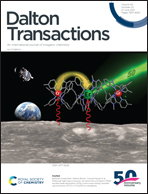Hydrothermal synthesis, crystal structures, and X-ray photoelectron spectroscopy of lead tellurium(iv) and tellurium(vi) oxycompounds: Ba3PbTe6O16 and Na2Pb9(μ6-O)2(Te2O10)2†
Abstract
An exploratory study of the lead-tellurium-oxygen phase space led to two new compounds, Ba3PbTe6O16 (BPTO) and Na2Pb9(μ6-O)2(Te2O10)2 (NPTO), which were synthesized under hydrothermal conditions at 550 °C and 210 °C, respectively, and characterized by single-crystal X-ray diffraction, infrared and X-ray photoelectron spectroscopy. BPTO adopts a layer structure. The Te4+ cation in BPTO is bonded to four oxygen atoms at about 2.0 Å with two more oxygens at about 3.0 Å. The seesaw-shaped TeO4 units share corners to form 2D layers containing six-membered rings and the Ba2+ and Pb2+ cations are situated in the interlayer region. The structure of NPTO contains dimers of edge-sharing Te6+O6 octahedra, which are connected through five-coordinate Pb2+ cations. A unique six-coordinate O atom is at the center of the octahedron formed by five Pb2+ and one Na+ cations. BPTO is one of the few metal tellurites which were synthesized under supercritical hydrothermal reaction conditions. The Pb2+ cation in NPTO shows pronounced stereochemical effects of the lone electron pair. In contrast, BPTO shows no stereochemical evidence of the inert pair.



 Please wait while we load your content...
Please wait while we load your content...